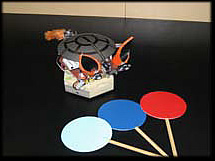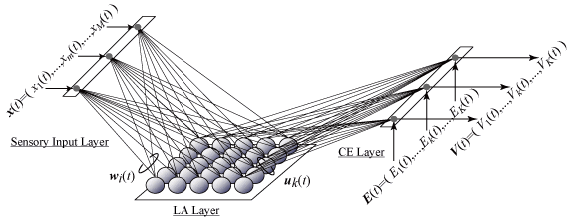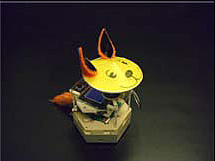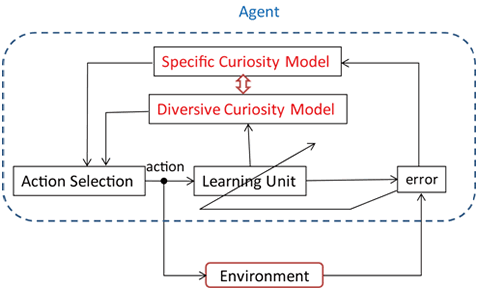 |
 |
 |
[ Development of behavior expression models based on psychology-emotion, and its hardware implementation ] |
 |
 |
Sub-project leader : Yamakawa |
|
 |
|
 |
 |
| (1) |
Vision SP
We are working on a development of models and devices that brain information processing about psychology-emotion was applied for engineering. The project consists of researches on wide area such as cognitive psychology, cognitive neuroscience, soft-computing and integrated circuit technology. Multi-disciplinary research has been carried out by integrating professional knowledge and technology of each field.
In this subproject, two functions involved in an intrinsic motivation of animals, “emotion” and “curiosity”, have been modeled from the point of view of brain-inspired technology. Furthermore, these models were successfully implemented in an autonomous robot.
|
 |
| (2) |
Members
| Leader: |
Prof. Takeshi Yamakawa (Brain-Like Computers) |
| Members: |
Prof. Zimin Lev Grigorievich (Brain-Like Computers)
Prof. Shuji Aou (Cognitive Neuroscience)
Prof. Akitoshi Hanazawa (Attention and consciousness)
Prof. Hideki Nakagawa (Releasing Mechanisms of Behavior)
Hirohisa Isogai (Cognitive Psychology of Human Behavior)
Takayuki Toyoshima (Mathematical Linguistics)
Keiichi Horio (Computational and Cognitive Brain Science)
Masaharu Mizuno (Higher Brain Functions)
|
|
 |
| (3) |
Figure captions |
 |
Emotional expression algorithm inspired by the amygdala [1][2]
 It is well known that emotions are controlled by the amygdala which is considered to be a part of the cerebral limbic system. In the amygdala, the sensory stimulus is evaluated according to its emotional values. And then, the emotional response is transmitted to the corresponding systems from the amygdala. The emotional response relates very closely to learning and memory system of animals. This means that emotions have a significant role to play on animal's behavior.
It is well known that emotions are controlled by the amygdala which is considered to be a part of the cerebral limbic system. In the amygdala, the sensory stimulus is evaluated according to its emotional values. And then, the emotional response is transmitted to the corresponding systems from the amygdala. The emotional response relates very closely to learning and memory system of animals. This means that emotions have a significant role to play on animal's behavior.
The aim of this research is the development of an emotional expression algorithm from the point of view of brain-inspired technology. We have proposed the emotional expression model of the amygdala and developed the specific hardware for the proposed model as well. Furthermore, an implementation of the proposed model was successfully archived in order to make an autonomous robot generate the emotions.
|
 |
 |
| Figure 1: Emotional expression Model of the Amygdala; EMA. EMA emulates functions and structures of the amygdala. Emotional expression by EMA can be achieved by a combination of recognition of sensory stimulus and the classical conditioning. |
|
 |
 |
Demonstration
Movie
(mov:20MB)
|
: |
An autonomous robot “WITH” (*) which has the proposed model, EMA. WITH can generate some emotions such as fear and pleasure to sensory stimulus (colored-marker) and can achieve emotional interaction.
|
|
 |
 |
| Page top ↑ |
 |
Curiosity-driven behavior expression algorithm [3][4][5]
 Curiosity is categorized into diversive curiosity and specific curiosity. Diversive curiosity tends to let agent broadly seek information about environment. On the contrary, specific curiosity tends to let agent seek limited information which engage agent's interest. Higher order living organisms realize proactive and efficient learning by adjusting activation ratio of these two curiosities.
Curiosity is categorized into diversive curiosity and specific curiosity. Diversive curiosity tends to let agent broadly seek information about environment. On the contrary, specific curiosity tends to let agent seek limited information which engage agent's interest. Higher order living organisms realize proactive and efficient learning by adjusting activation ratio of these two curiosities.
In this study, we aim at development of curiosity-driven action selection model from engineered approaches and perspectives based on psychological consideration regarding curiosity. We proposed curiosity-driven behavior expression algorithm and implement the proposed algorithm in the autonomous robot. Finally, we achieved the behavior expression of the robot by curiosity.
|
 |
 |
| Figure 2: The proposed learning model with two kinds of curiosity; “diversive curiosity” and “specific curiosity”. |
|
 |
 |
Demonstration
Movie
(mov:12MB)
|
: |
“WITH” which has the proposed curiosity model are learning movements of markers based on curiosity. WITH rotates toward the most interesting marker that is a source of the highest curiosity.
|
|
 |
|
 |
| Selected Papers |
| [1] |
S. Sonoh, S. Aou, K. Horio, H. Tamukoh, T. Koga, N. Shimo and T. Yamakawa, Emotional behavior and expression based on a neural network model of amygdala, Abstract of the 4th International Conference on Brain-Inspired Information Technology (BrainIT 2007), p.36, 2007.
|
| [2] |
S. Sonoh, S. Aou, K. Horio, H. Tamukoh, T. Koga, N. Shimo, R. Nishioka, M. Doi and T. Yamakawa, Training your animal-like robot by yourself: Hardware implementation of amygdala model, Abstract of the 4th International Conference on Brain-Inspired Information Technology (BrainIT 2007), p.74, 2007.
|
| [3] |
N. Shimo, S. Pang, K. Horio, N. Kasabov, H. Tamukoh, T. Koga, S. Sonoh, H. Isogai and T. Yamakawa, Effective and Adaptive Learning based on Diversive/Specific Curiosity, Abstract of 4th International Conference on Brain-Inspired Information Technology (BrainIT2007), p.xx, 2007.
|
| [4] |
N. Shimo, S. Pang, K. Horio, N. Kasabov, H. Tamukoh, T. Koga, S. Sonoh, H. Isogai and T. Yamakawa, The Robot Stealing the Characteristic Behavior out of the Partner, Abstract of 4th International Conference on Brain-Inspired Information Technology (BrainIT2007), pp.75, 2007.
|
| [5] |
N. Shimo, S. Pang, N. Kasabov, T. Yamakawa, Curiosity-Driven Multi-Agent Competitive and Cooperative LDA Learning, International Journal of Innovative Computing, Information & Control, vol.4, no.7, 2008.
|
|
|
|